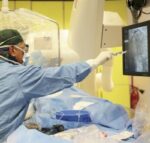The Internal Mammary Artery (IMA) is the preferred conduit for bypassing the left anterior descending artery (LAD) in patients undergoing coronary artery bypass grafting. There is no systematic evaluation of the frequency and predictors of IMA failure or long-term outcomes. The PREVENT IV included 1539 patients receiving IMA-LAD revascularization with 12 and 18 month<a href="https://solaci.org/en/2015/12/24/predictors-of-internal-mammary-artery-graft-failure/" title="Read more" >...</a>
Coronary flow reserve is associated to adverse events regardless angiographic severity.
This study included 329 consecutive patients derived to coronary angiography based on myocardial perfusion tests or PET scan (positron emission tomography). The extension and severity of heart disease was assessed by angiography, and coronary flow reserve (CFR) was measured non-invasively by PET. After adjusting risk factors, ejection fraction, revascularization, etc, both the severity of angiographic<a href="https://solaci.org/en/2015/06/24/coronary-flow-reserve-is-associated-to-adverse-events-regardless-angiographic-severity/" title="Read more" >...</a>
OPTIMIZE: 3 months versus 12 months of dual anti-aggregation with zotarolimus-eluting stents
The current recommendation for dual anti-aggregation post-DES implantation is 12 months. However, the ideal length for specific types of stents is unclear. This study aimed to evaluate the clinical non-inferiority at 3 months versus 12 months of dual anti-platelet therapy in patients undergoing coronary angioplasty with zotarolimus-eluting stents. The study randomized 1:1 to 3 months<a href="https://solaci.org/en/2015/06/24/optimize-3-months-versus-12-months-of-dual-anti-aggregation-with-zotarolimus-eluting-stents/" title="Read more" >...</a>
PARIS register: Non-adherence impact to antiplatelet therapy among men and women
The PARIS registry was a prospective observational study in 5018 patients undergoing coronary angioplasty with stent implantation in 15 centers. Three categories were prespecified in the discontinuation of dual antiplatelet therapy: 1) discontinuation for medical guidance, 2) transient discontinuation for less than 15 days for surgery and 3) permanent abandonment of it by non-adherence or<a href="https://solaci.org/en/2015/06/24/paris-register-non-adherence-impact-to-antiplatelet-therapy-among-men-and-women/" title="Read more" >...</a>
SCIPIO trial: Intracoronary infusion of autologous cardiac stem cells improve ventricular function.
This is the first trial that used autologous cardiac stem cells for the treatment of ischemic cardiomyopathy. It consecutively enrolled 37 patients with reduced ejection fraction (lower than 40%) before myocardial revascularization surgery. It was administered by intra coronary infusion and 17 were control subjects. In the group injected with stem cells, EF significantly improved<a href="https://solaci.org/en/2015/06/24/scipio-trial-intracoronary-infusion-of-autologous-cardiac-stem-cells-improve-ventricular-function/" title="Read more" >...</a>
FREEDOM trial: CABG versus angioplasty treatment for diabetic patients with multivessel disease
The trial included 1,900 patients followed for at least 2 years, (mean 3.8 years), randomized 1:1 to pharmacological angioplasty stents, (sirolimus or paclitaxel at surgeon discretion), or CABG. We excluded acute coronary syndromes and left coronary trunk injury. The primary endpoint was death, myocardial infarction or stroke and the secondary main was the sum of<a href="https://solaci.org/en/2015/06/24/freedom-trial-cabg-versus-angioplasty-treatment-for-diabetic-patients-with-multivessel-disease/" title="Read more" >...</a>
EXPAND: expanding the applications of bioresorbable platforms
There is little information about the use of bioresorbable vascular devices in patients with a reference diameter ≥4mm, long, bifurcation, calcified or unstable lesions. The BVS-Expand registry is a single-center study that evaluates the safety and efficacy of this device in past populations (real world).The primary endpoint was the occurrence of MACE (cardiac death, myocardial<a href="https://solaci.org/en/2015/06/24/expand-expanding-the-applications-of-bioresorbable-platforms/" title="Read more" >...</a>
SYNTAX II: multiple vessels using iFR / FFR and IVUS
This study is still in progress and includes patients using SYNTAX II score based on functional invasive evaluation with iFR / FFR and performing angioplasty guided by IVUS using the biodegradable polymer everolimus eluting stent. The study seeks to prove superiority versus the first generation paclitaxel-eluting stent and non-inferiority versus surgery using historical data. We<a href="https://solaci.org/en/2015/06/24/syntax-ii-multiple-vessels-using-ifr-ffr-and-ivus/" title="Read more" >...</a>
PCI with everolimus eluting stent or CABG for multivessel coronary artery disease.
Original title: Everolimus-Eluting Stents or Bypass Surgery for Multivessel Coronary Disease. Reference: Sripal Bangalore, M.D. et al. N Engl J Med. 2015 Mar 26;372(13):1213-22. Coronary artery bypass grafting (CABG) have had better outcomes than percutaneous coronary intervention (PCI) in the treatment of multivessel coronary disease. However, this information comes from studies that do not include new generation stents.<a href="https://solaci.org/en/2015/04/09/pci-with-everolimus-eluting-stent-or-cabg-for-multivessel-coronary-artery-disease/" title="Read more" >...</a>
Partial occlusion of coronary sinus reduces refractory angina
Original title: Efficacy of a Device to Narrow the Coronary Sinus in Refractory Angina. Reference: Verheye S et al. N Engl J Med 2015 Feb 5;372(6):519-27. The number of patients with severe diffuse coronary artery disease who are not candidates for revascularization is growing in Western countries, generating multiple procedures and increasing healthcare expenditure. New and unconventional solutions<a href="https://solaci.org/en/2015/02/26/partial-occlusion-of-coronary-sinus-reduces-refractory-angina/" title="Read more" >...</a>









